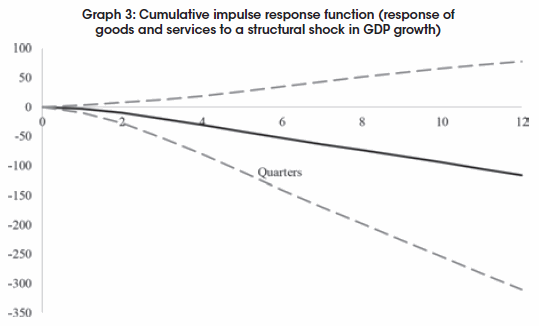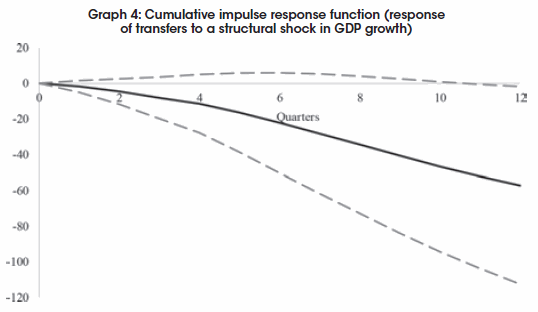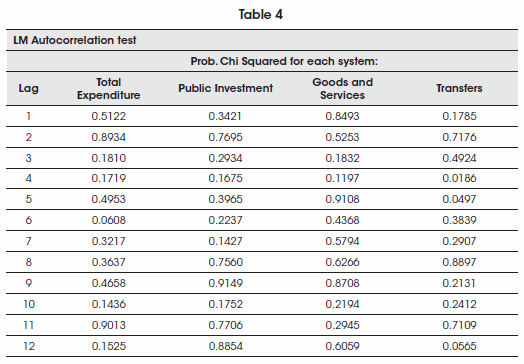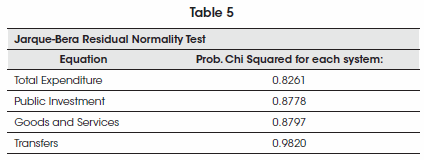Servicios Personalizados
Revista
Articulo
Indicadores
Links relacionados
Compartir
Revista Latinoamericana de Desarrollo Económico
versión impresa ISSN 2074-4706versión On-line ISSN 2309-9038
rlde n.27 La Paz mayo 2017
On Graduation from Fiscal Procyclicality: The case of Bolivia
Sobre la graduación de la prociclicidad fiscal: el caso de Bolivia
Rodrigo Gonzáles Zuazo*, José Miguel Molina Fernández**
Abstract
Since Frankel et al. (2013), many authors have sought evidence of the so-called graduation from fiscal procyclicality; this concept refers to the direction change experienced by a number of developing countries regarding the implementation of destabilizing procyclical policies in the past.
While the cyclicality of fiscal policy in Bolivia has been evaluated by multiple authors, we believe that our contribution is relevant because it models the response of fiscal policy in a much more intuitive way that is also less prone to some specification problems frequently cited in the literature.
Keywords: Business cycles, fiscal policy, graduation from fiscal procyclicality
Resumen
Desde el trabajo de Frankel et al. (2013), muchos autores han buscado evidencia de la llamada graduación en el manejo contracíclico de las políticas; este término hace referencia al cambio de dirección experimentado por una serie de países en desarrollo con respecto a la implementación de políticas procíclicas desestabilizadoras en el pasado.
Si bien la ciclicidad de la política fiscal en el país ha sido evaluada por múltiples autores, creemos que el análisis que presentamos a continuación es relevante porque modela la respuesta de la política fiscal de una manera mucho más intuitiva y robusta a ciertos problemas de especificación frecuentemente citados en la literatura.
Palabras clave: Ciclos económicos, política fiscal, graduación de la prociclidad fiscal.
Classification/Clasificación JEL: E62, E32.
1. Introduction
The debate about the role of government in reducing or amplifying economic fluctuations is one of the most heated, not only among economists, but also between external analysts and the public at large. By its controversial nature, the arguments involved, should always be supported by evidence.
The purpose of this paper is to contribute to this debate by assessing the cyclicality of fiscal policy in Bolivia in recent years. In the fiscal sphere, we say that the implemented policies are procyclical ifthey are expansive (contractive) in the expansive (contractive) phase of business cycle and are countercyclical if they are expansive (contractive) in the recessive (expansive) phase ofbusiness cycle.
Although there is no total theoretical consensus on this1, it is said that fiscal policy is optimal when it is countercyclical. Why? Because if fiscal policy is countercyclical, government can accumulate resources in times of prosperity to drive the weak demand for goods and services in crisis episodes by expanding current spending and public investment2.
We focus on the last administrations (2000-2014), since we seek to confirm if Bolivia is part of what the recent literature has called the graduation from fiscal procicality; this term makes reference to the direction change experienced by a number of developing countries with regard to the implementation of destabilizing procyclical policies in the past.
While the cyclicality of fiscal policy in Bolivia has been evaluated by multiple authors, we believe that the analysis presented below is relevant because of two marked differences from previous research:
i. The definition of procyclicality is modelled more intuitively and, in our view, in a much more convincing way since we do not rely on the existence of a full employment growth rate (or our ability to know it with certainty). Instead, we answer the following question: How does fiscal policy respond to product accelerations and decelerations?
ii. The typical problem of simultaneity in estimating the cyclicality of fiscal policy is overcome with a specification where the independent variables are predetermined (and the potential problems of endogeneity not solved by the proposed specification are dealt with valid instruments).
The structure of the document is as follows. In Section 2, we make a brief review of the literature with emphasis on discussions on the optimality of countercyclical fiscal policy and evidence for developing countries and for Bolivia. Section 3 describes the specification of the econometric models used in the empirical evaluation. In section 4, we describe the data used in the subsequent econometric analysis, and with them a first inspection is made to the relation between fiscal policy and economic activity in the country In section 5, the results of the estimates are presented. In section 6, we summarize our main conclusions.
2. Literature review
Recent literature has documented significant improvements in several developing countries in relation to the implementation of countercyclical fiscal and monetary policies in a context marked by two important facts: the boom in prices of export commodities and the Great Recession3.
Since Frankel et al. (2013), many authors have sought evidence of the so-called graduation from fiscal procyclicality; this concept refers to the direction change experienced by a number of developing countries regarding the implementation of destabilizing procyclical policies in the past.
Klemm (2014) finds evidence of procyclicality in Latín America and Bolivia instead (when internalizing the automatic stabilizers in the primary structural budget balance). The disparity of conclusions on the cyclicality of fiscal policy may be due in large part by the definitions of cyclicity on the one hand and empirical methods used by another4.
Following Ilzetzky and Vegh (2008), in the present work we use fiscal variables that can be considered as instruments of policy action to attenuate the cycle from the policy maker's perspective. For example, we discard the use of the budget balance of the government because its evolution is conditioned to the business cycle, and when evaluating the cyclicality of fiscal policy, there are endogenous components that prevent to see the clear sign of the response.
In terms of tax revenue, the policy instruments are the tax rates and not tax revenues as such.
On the side of fiscal expenditures, the rigid components such as expenditure on salaries or debt service should not be analyzed. We identify three policy instruments on the expenditure side: public investment, government spending on goods and services, and transfers.
In general, the literature has identified three possible explanations for the procyclical behavior of fiscal policy:
i. External credit restrictions and financial depth that would limit the borrowing capacity of governments to smooth the business cycle5.
ii. Political economy problems and institutional quality of governments to deal with rent-seeking pressures, which is a common problem in countries that export commodities mainly6.
iii. Economic inequality that prevents the correct functioning of automatic stabilizers, since changes in the tax base during the cycle are unequally concentrated in the sectors7.
The desirability for a contrary reaction of government to the level of economic activity corresponds to the traditional Keynesian approach based on the intuition of the IS-LM model.
In the presence of nominal rigidities and without money neutrality, product fluctuations are undesirable and can be corrected through countercyclical fiscal and monetary policies.
However, from the neoclassical perspective the desired direction of fiscal policy is not clear. If Ricardian equivalence is fulfilled, spending as a policy instrument is ineffective and therefore irrelevant during the cycle. On the income side, smoothed taxation á la Barro suggests maintaining constant tax rates (against transient shocks) as an optimal policy8. In sum, in the neoclassical world the tax rates policy should be acyclical.
The studies that have attempted to evaluate the cyclicality of fiscal policy in Bolivia have been based on the relationship between the fiscal impulse and the output gap9. The fiscal impulse is an indicator derived from the fiscal balance adjusted by cyclical factors (or full employment balance budget) that allows to characterize the fiscal policy as expansive or contractive.
Both, fiscal impulse and output gap estimates requires time series filters to separate cyclical and trend components. As Klemm (2014) mentioned, the Hodrick and Prescott (HP) filter has been conventionally used for this purpose10.
3. Econometric models
In this section, we develop the specification of two econometric models that allow us to characterize the cyclical behavior of fiscal policy.
We understand the cyclicality of fiscal policy as the response of the variables of public expenditure to changes in the rhythm of real GDP growth. The reasoning behind this definition is that positive growth rates are not necessarily "good" and may even coexist with episodes of "crisis" in the sense of the perception of the term by the general public. For our purposes, growth rates represent the state of economic activity better.
The world of causal relationships we try to model to assess the cyclicality of fiscal policy goes in one direction: we say that product accelerations (decelerations) cause some fiscal policy response. However, there may also be causality in the opposite direction, since government spending is a direct component of aggregate demand11.
The two models that we consider for estimating the cyclicality of fiscal policy -detailed below- take into account this potential endogeneity issues.
3.1. Ordinary Least Squares (OLS)
Under our definition of expenditure cyclicity its direction and magnitude can be estimated by a simple regression as the following:
![]()
Where:
git is the logarithm of government spending or some of its components.
gpibt-1 is the annual growth rate of real GDP in the previous period12.
zit is a group of exogenous controls.
Since the annual growth rate of GDP can't depend on government spending in the future, it's hard to think of any endogeneity problems. A channel through which endogeneity bias problems can arise is explored in Appendix A.
The OLS estimate will be consistent, since the annual growth rate of lagged GDP is predetermined.
The regression includes deterministic components (including structural breaks), a lag of the dependent variable and a lag of the external debt/GDP ratio as control variables. The Quandt-Andrews structural break test determined the inclusion of structural breaks and their occurrence periods. A lag of the dependent variable is included to control for inertia and reduce autocorrelation problems. The external debt/GDP ratio controls the constraints on fiscal policy response to the business cycle phase in the presence of financing constraints.
3.2. Structural Vector Autorregression Model (SVAR)
In the spirit of Ilzetzky and Vegh (2008), we start from the following SVAR:
![]()
The vector ![]() contains the logarithm of the components of public expenditure (git) and output rate growth (gpibt). The A matrix, relates contemporaneously the variables in vector Yt . And following Blanchard y Perotti (2002) idea, we are going to assume that fiscal policy does not react contemporaneously to changes in the level of activity but does so after a quarter.
contains the logarithm of the components of public expenditure (git) and output rate growth (gpibt). The A matrix, relates contemporaneously the variables in vector Yt . And following Blanchard y Perotti (2002) idea, we are going to assume that fiscal policy does not react contemporaneously to changes in the level of activity but does so after a quarter.
This constraint is imposed by defining the B matrix as a lower triangular, resulting from a Cholesky decomposition, so, the vector of orthogonalized errors et is iid. We have:

4. The data
The study period covers the years 2000-2014, following other authors who have documented graduation from fiscal procicality We use quarterly data13.
The Bolivian tax system has differentiated tax rates for different taxable bases14, with a virtually constant evolution. Both facts make it difficult to assess the cyclical response of tax rates.
Consequently, and without loss of generality, we decided to evaluate cyclicality on the expenditure side only Data on capital expenditures (public investment), expenditure on goods and services and transfers15 is obtained from the Consolidated operations of the non-financial public sector. We then define total expenditure as the sum of the three:
Total Expendituret = Public Investmentt + Goods and Services Expendituret + Transferst
The variables are expressed in real terms. Public investment has been deflated using the public gross fixed capital formation deflator Índex, while the remaining two components have been deflated by the public administration final consumption expenditure deflator index. Both indexes (base year = 1990) are available on the website of the National Institute of Statistics (INE)16.
The external public debt to GDP ratio comes from the International Operations Department of the Bolivian Central Bank (BCB)17.
5. Estimations results
5.1. Ordinary Least Squares (OLS)
We have estimated four equations, one for each component of public expenditure and another for total expenditure. The variance-covariance matrix has been estimated by the HAC Newey West method to correct the problems of autocorrelation and heteroscedasticity The cyclicality of fiscal expenditure is assessed by the coefficient α from equation (1). A positive and significant coefficient would indicate procicality and a negative and significant counterciclicality.
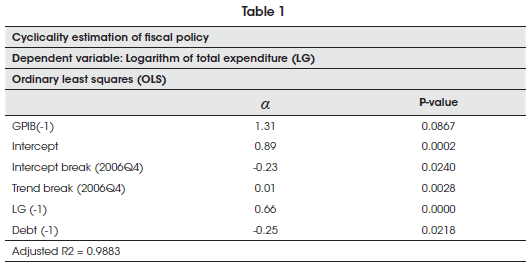
We can say at a 95% confidence level that Bolivias fiscal policy has actually been acyclical (although there are indications of procyclicality at 90% confidence level).
As for total expenditure, the equations for the relevant components of fiscal expenditure have been estimated following the specification of equation (1). Table 2 shows that public investment, goods and services expenditure and transfers are also acyclical.

5.2. Structural Vector Autoregression model (SVAR.)
Although we are interested in knowing the general direction of the cyclicality of fiscal policy getting to know how it reacts to unexpected changes in the annual GDP growth rate is perhaps the most relevant question.
The cumulative impulse response functions (CIRF) allow us to see how fiscal expenditure responds to a structural shock in the output growth. We have estimated the CIRF for 20 periods (5 years) horizon. The optimal number of lags election has been guided by information criteria (as corrected by Lütkepohl). In order to make the results of the OLS and SVAR models comparable, we have included as exogenous variables the external debt/ GDP ratio and the trend in the equations of the logarithm of fiscal variable and of the product growth; and only in the first equation the breaks (in intercept and trend) as they correspond in the specification of OLS equation. In addition, the confidence intervals were simulated by 2000 bootstrap replicates at 95% confidence level18.
Showing up next, graph 1 presents the response of the logarithm of total expenditure to a structural shock in product growth:
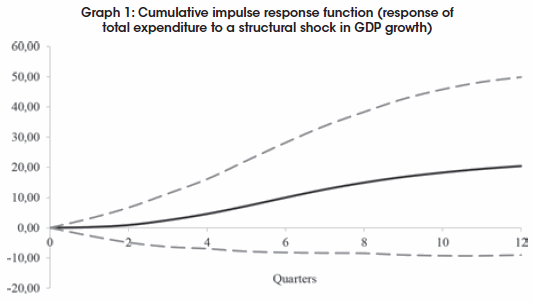
The response is not significant. This estimate supports the result found by the OLS regression and adds evidence to affirm that fiscal policy in Bolivia is acyclical indeed.
For the estimation of the response of public investment, goods and services expenditure and transfers, a similar procedure has been followed. The results are presented in appendix B, along with the corresponding LM autocorrelation tests and Jarque-Bera tests for all estimations.
6. Conclusions
Several studies have documented improvements in fiscal policy management in relation to economic activity in several developing countries, including Bolivia. This has been attributed mainly to improvements in public finance institutions and to greater financial integration.
However, there is also some evidence that this has not really happened. The diversity of methodologies on cyclicality of fiscal policy led us to think of a more intuitive definition for modeling it. We analyze the cyclical response of three components of government expenditure and aggregate expenditure, and in all cases we find that fiscal policy in Bolivia is acyclical, in support of Puig's (2015) conclusions and in disagreement with the ones in Valdivia (2014), BCB (2014) and Ugarte (2016) who assert that fiscal policy is countercyclical.
How can we interpret these results in the Bolivian context? We believe that the acyclical behavior of fiscal policy in Bolivia during the period 2000-2014 is explained by at least three factors:
i. The absence of fiscal rules.
ii. The fact that the nationalization of hydrocarbons (and industrialization projects), the increasing spending on infrastructure, health and education, or the process of regional decentralization, were due to social issues rather than due to business cycle smoothing objectives.
iii. The lag and coverage of automatic stabilizers. Given the high levels of informality in labour markets and with many companies in the informal sector, there are difficulties to adjust the tax base throughout the cycle (worth mentioning even if we haven't explored the ciclicality of revenue).
The fact that fiscal policy in the country is acyclic merely reflects the fact that reducing short-term fluctuations in economic activity has not been a priority objective on the agenda of the policy makers of the new millennium. Whether this economic policy decision can be considered good one or not is left to the reader s judgment.
Fecha de recepción: 16 de enero de 2017
Fecha de aceptación: 24 de abril de 2017
Manejado por la A.B.C.E.
Notas
* Research Fellow at Ciess Econométrica and Universidad Mayor de San Andrés. Arce Avenue 2335, Cobija building. La Paz-Bolivia.Phone: (591) 74071200,fax: (591) 2443648. Contact: rodrigogonzaleszuazo@hotmail.com
** Universidad Mayor de San Andrés. Nanawa Street, Alooreza alley # 1874. Phone: (591) 73267757. Contact: joselitojnmvi@hotmail.com
1 We examine this question in more detail in the section devoted to literature review.
2 Economists have not been the first or only ones to take an interest in the subject. See Genesis 41:1-36.
3 For example, Vegh and Vuletin (2014 and 2016), Alberola et al. (2016), Fernández-Arias and Pérez (2014), Céspedes and Velasco (2013) and Frankel et al. (2013).
4 This point ¡s treated by Halland and Bleaney (2009) and Fatás and Mihov (2009).
5 The pioneering paper of Gavin and Perotti (1997) was followed by several papers suoh as Riascos and Vegh (2003), Khamisnky et al. (2004), Caballero and Krlshmamurthy (2004), Mendoza and Oviedo (2006),Calderón and Sohmidt-Hebbel (2008) and Alberola et al., (2016).
6 For example, Lane (2003),Talv¡ and Vegh (2005), Aleslna and Tabelllnl (2005), Aleslna et al. (2008), Ilzetzky (2011) and Calderón et al. (2012).
7 However, there ¡s few evidence that support this argument; for example, see Woo (2009).
8 However, Barro's (1979) argument ¡s disputed by Chari, Christiano and Kehoe (1994), who argue that wages are ¡mpacted by product fluctuations and therefore the tax policy is relevant in oycle mitigation.
9 For example Ugarte (2016) and Valdivia (2014).
10 About this important point, Hamilton (2016) demonstrates the inconsistent dynamic relationships that are generated by using the HP filter.
11 Causality ¡n the second direction has to do with the multiplier of fiscal policy (for Bolivia, see Puig, 2015). The phenomenon "when it rains, it pours" argues that the causal relationship is fulfilled in both directions (Khamisky et al., 2004 and llzetzky and Vegh, 2008).
12 As we work with quarterly data, the GDP growth rate is defined as follows:
13 Due to the annual availability of some data, we used the Denton-Cholette temporal disaggregation procedure (from the tempdissag paokage ¡n R).
14 In Bollvla there are 13 types of taxes (IVA, IT, IUE, RC-IVA, ICE.TGB, ISAE, IEHD, IDH, ITF, IJ, IPJ and IVME)
15 Data extracted from UDAPE-Statistics Dossier.
16 For the trimestralisation of the series we used as referenoe ¡ndioator the public administration final consumption expenditure of GDP by expenditure type, base 1990.
17 The frequency of this indicator has been also changed to quarterly.
18 It ¡s important to mention that the equations in the SVAR model were estimated by the SUR method and not by OLS since we imposed the presence of the control variables only on GDP~s equations.
19 For all the equations the variance-covarlance has been estlmated by matrlx HAC (Newey-West).
20 Serles extracted from the OECD database.
21 Series extracted from Robert Shiller online database.
22 That ¡s to say, affecting the annual GDP growth rate contemporaneously and with a two year lag respectively.
References
1. Alberola, E., I. Kataryniuk, A. Melguizo & R. Orozco. 2016. "Fiscal policy and the cycle in Latin America: the role of financing conditions and fiscal rules". Bank for International Settlernents Working Papers.
2. Alesina, A. & G. Tabellini. 2005. "Why Is Fiscal Policy Often Procyclical?" Working Papers 297, IGIER (innocenzo Gasparini Institute for Economic Research), Bocconi University
3. Alesina, A., E R. Campante & G. Tabellini. 2008. "Why is Fiscal Policy Often Procyclical?" Journal of the European Economic Association, MIT Press, 6(5), 1006-1036.
4. Ardanaz, M., A. Corbacho, A. Gonzáles & N. Tolsa Caballero. 2015. "Structural fiscal balances in Latin America and the Caribbean: new dataset and estimations". IDB Working Paper Senes N° IDB-WP-579.
5. Barro, R. 1979. On the Determination of Public Debt. Journal of Political Economy, 87, 940-971. [ Links ]
6. BCB. 2014. El rol estabilizador de la política fiscal en el nuevo modelo económico boliviano. Banco Central de Bolivia. La Paz, Bolivia.
7. Blanchard, O. & R. Perotti. 2002. An Empirical Characterization of the Dynamic Effects of Changes in Government Spending and Taxes on Output". Quarterly Journal of Economics, 117,1329-1368.
8. Caballero, R. J. & A. Krishnamurthy 2004. "Fiscal Policy and Financial Depth". Depth NBER Working Paper No. 10532.
9. Calderón, C. & K. Schmidt-Hebbel. 2008. "Business Cycles and Fiscal Policies: the Role of lnstitutions and Financial Markets". Working Papers Central Bank of Chile, 481, Central Bank of Chile.
10. Calderón, C, R. Duncan & K. Schmidt-Hebbel. 2012. "Do good institutions promote counter-cyclical macroeconomic policies?" Globalization and Monetary Policy Institute, Working Paper 118, Federal Reserve Bank of Dallas.
11. Céspedes, L. E & A. Velasco. 2013. "Was This Time Different? Fiscal Policy In Commodity Republics". NBER Working Paper 19748.
12. Chari, V V, L. J. Christiano & P J. Kehoe. 1994. "Optimal Fiscal Policy in a Business Cycle Model". Journal of Political Economy, University of Chicago Press, 102 (4), 617-52.
13. Fatas, A, & I. Mihov. 2009. "The Euro and Fiscal Policy". NBER Working Papers 14722, National Bureau of Economic Research, Inc.
14. Fernández-Arias, E. & J. E. Pérez. 2014. "Grading Fiscal Policy in Latin America in the Last Decade". Inter-Arnerican Development Bank Department of Research and Chief Economist Policy Brief, N° IDB-PB-216.
15. Frankel, J. A., C. Vegh & G. Vuletin. 2013. "On graduation from fiscal procyclicality". Journal of Development Economics,vol. 100:32-47.
16. Gavin, M. & R. Perotti. 1997. "Fiscal Policy in Latin America". NBER, vol. 11:11 -72.
17. Gonzáles, R. 2016. "External Shocks, Dutch Disease and Informality in Bolivia". Ciess Econométrica-Universidad Mayor de San Andrés.http://r4d.africantransformation.org/category/working-papers/. [ Links ]
18. Halland, H. & M. Bleaney (2009). "Explaining The Procyclicality of Fiscal Policy in Developing Countries". Discussion Papers 11/09, University of Nottingham, CREDIT.
19. Hamilton, J. 2016. "Why You Should Never Use the Hodrick-Prescott Filter". Department of Economics, UC San Diego.
20. Ilteztzky E. 2011. "Fiscal policy and debt dynamics in developing countries". Policy Research Working Paper Series 5666, The World Bank. [ Links ]
21. Ilzetzky E. & C. Vegh. 2008. "Procyclical Fiscal Policy in Developing Countries: Truth or Fiction?". NBER Working Paper N° 14191.
22. Kaminsky G., C. Reinhart & C. A. Vegh. 2004. "When It Rains It Pours: Procyclical Capital Flows and Macroeconomic Policies". NBER Macroeconomics Annual, edited by Mark Gertler and Kenneth Rogoff, Cambridge, MA: MIT Press.
23. Klemm, A. 2014. "Fiscal Policy in Latin America over the Cycle". IMF Working Paper Western Hemisphere Department. [ Links ]
24. Lane, P 2003. "The Cyclical Behavior of Fiscal Policy: Evidence from the OECD". Journal of Public Economics, 87:1661-2675. [ Links ]
25. Mendoza, E. & M. Oviedo. 2006. "Fiscal Policy and Macroeconomic Uncertainty in Developing Countries: The Tale of the Tormented Insurer". Mimeo (University of Maryland and Iowa State University)
26. Puig, J. P 2015. "Multiplicador del gasto público en Bolivia: una primera aproximación". Latin American Journal of Economic Development, N° 24. ISSN: 2074 - 4706,47 - 78.
27. Riascos, A. & C. A. Vegh. 2003. "Procyclical Government Spending in Developing Countries: The Role of Capital Market Imperfections". Mimeo (UCLA and Banco Republica, Colombia).
28. Strawczynski,M. & J. Zeira. 2011. "Procyclicality of Fiscal Policy in Emerging Countries: the Cycle is the Trend". Working Papers Central Bank of Chile N° 624, Central Bank of Chile.
29. Talvi, E. & C. A. Vegh. 2005. "Tax Base Variability and Procyclical Fiscal Policy in Developing Countries". Journal of Development Economics, 78(1), 156-190.
30. Ugarte, D. 2016. "Ciclicidad de la política fiscal en Bolivia". Cuadernos de Investigación Económica Boliviana, Ministerio de Economía y Finanzas Públicas, 7-53.
31. Valdivia, D. 2014. "Posición fiscal, monetaria y control de la brecha inflacionaria y del producto: evidencia empírica para Bolivia". MPRA Paper. [ Links ]
32. Vegh, C. & G. Vuletin. 2014. "The Road to Redemption: Policy Response to Crises in Latin America". IMF 14 TH Jacques Plak Annual Research Conference.https://www.imf.org/external/np/res/seminars/2013/arc/pdf/vegh.pdf
33. --------2016. "To be countercyclical or not? That is the question for Latin America". VOX CERP's Policy Portal, http://voxeu.org/article/be-countercyclical-or-not-question-latin-america. [ Links ]
34.Woo, J. 2009. "Why Do More Polarized Countries RunMore Procyclical Fiscal Policy?" The Review of Economics and Statistics, 91 (4), 850-870. [ Links ]
Appendix A
The Endogeneity Problem - IV/2SLS
The endogeneity problem may not be fully solved in equation (1). If government expenditure depends on the expected government expenditure in the previous period, it is possible that E(gpibt-1|ut)≠ 0, in which case the estimate by OLS would be inconsistent.
In order to deal with the problem of endogeneity bias, we estimated Instrumental Variables (IV) models by Two Stage Least Squares (2SLS).
We instrument the lagged annual GDP growth rate for the four estimated equations of fiscal expenditure components, namely total expenditure, public investment, goods and services expenditure, and transfers. The results of the 2SLS estimates are presented below:15
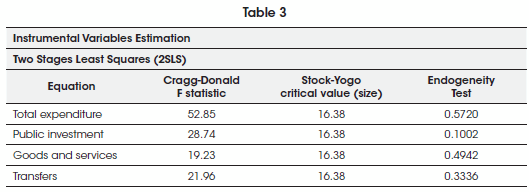
In all cases the instruments are valid (the nuil hypothesis that the instruments are weak is rejected) and the nuil hypothesis of non-endogeneity is not rejected.
The instruments used for the lag of product growth are described below. For the total expenditure equation, we use a lag of China consumer price index20. This is justified by the fact that China has conditioned global growth patterns in recent years and, under the accelerationist inflation hypothesis, deviations in the rate of inflation from their expected level translate directly into output growth rates above its full employment level. This undoubtedly affects output growth in Bolivia and there are no clear reasons to think that the exclusion restriction is not met.
In the public investment equation we used the third lag of S&P index21, while in the equation of goods and the equation of transfers, the instrument is the Shanghai Stock Exchange Composite Index, lagged one and nine periods respectively22. Instrumenting with stock indexes is supported by the fact that Bolivia is a small open economy, so it is a price-taker.
The instrument varíes from equation to equation by the fact that in each one there are different structural breaks that alter the estimation of the first stage.
Appendix B
Structural Vector Autoregression (SVAR)
In this appendix, we show the cumulative impulse response functions (CIRF) for the main components of fiscal expenditure and the respective LM and Jarque-Bera for the VAR models.

